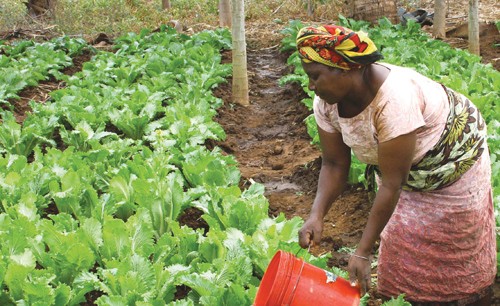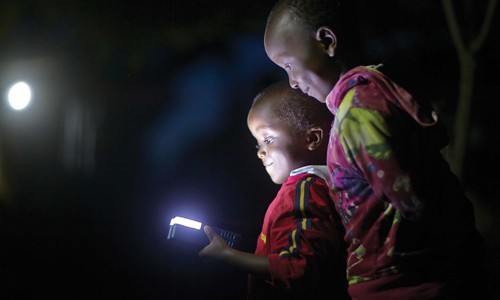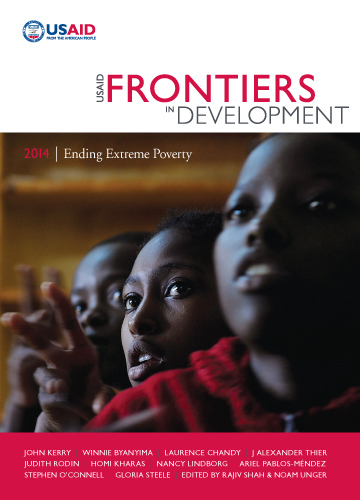Rajiv Shah and J Alexander Thier
In one sharp instant four years ago, more than 300,000 people died when a 7.0 magnitude earthquake shattered the island of Haiti. Six weeks later, an 8.8 magnitude earthquake struck Chile, and 525 people perished.
Remarkably, while Chile’s earthquake was 500 times more powerful, Haiti’s was 500 times deadlier—in large part, because of endemic poverty and poor governance. Haiti is the poorest country in the Western Hemisphere, with some 65 percent of Haitians living in extreme poverty. In 1984, 8 percent of Chileans lived in extreme poverty. Today, that number is just 1 percent. Chile’s buildings did not fall because they were built to seismic codes, rigorously enforced.

How do we build a world where such gross inequities are more relic than reality? The hallmark of extreme poverty is not just living on less than $1.25 a day. It is the denial of basic human dignity that locks a girl in daily terror of being sold off as a child bride. It is the denial of nutrition that allows the body to grow and the mind to thrive. It is the denial of opportunity for marginalized communities whose voices are muted and human rights violated. It is the blindness of illiteracy, the insecurity of slum housing and the relentless carnage of millions of children dying for lack of inexpensive, low-tech cures.
We know it does not have to be this way. From 1990 to 2010, child mortality fell by half; the number of children in primary school grew to nearly 90 percent; and around 2 billion people gained access to improved water sources. In just two decades, an additional 700 million people claimed freedom from extreme poverty, as the number of people enduring these gut-wrenching conditions began falling across the world. In 1990, one in three people lived in extreme poverty. Today, it is less than one in five. Evidenced in plummeting infant mortality rates, increasing access to primary education, especially for girls, and rising incomes for poor farmers, this progress has convinced us that ending extreme poverty in a generation is possible.
An Unprecedented Vision
But just knowing we are capable of ending extreme poverty is not enough. We need the political will. In February 2013, during his State of the Union address, President Barack Obama called upon our nation to join our partners to end extreme poverty and its most devastating consequences. It was an extraordinary moment, as the president set forth a vision for one of the greatest contributions to human progress in history.
In the months since, this vision has been powerfully echoed in the World Bank’s new mission and in the final report of the U.N. Secretary General’s High-level Panel on the Post-2015 Development Agenda, co-chaired by the leaders of Indonesia, Liberia and the United Kingdom. To ensure that this goal serves as the focal point of USAID’s efforts around the world, our Agency updated its own mission statement: “We partner to end extreme poverty and promote resilient, democratic societies while advancing our security and prosperity.”
We know the alternative. We know that where we see extreme poverty, extreme climate change and extreme ideology today, we are more likely to face conflict tomorrow. Our future prosperity and security are determined by factors beyond military might: the ingenuity of our innovators, the discoveries of our scientists and the compassion of our spirit. That is why President Obama elevated development as a core pillar of our national security and foreign policy, and leaders on both sides of the aisle have united behind the global effort to make extreme poverty a thing of the past.
A New Model of Development
To match the audacity of our goals and the resources necessary to achieve them, we need a new model of development. A generation ago, public funding from wealthy nations like the United States represented more than a majority of the external resources that came into developing countries. Today, by some recent estimations, donor resources represent no more than one-fifth—and possibly less than one-tenth—of external financing, with foreign direct investment, remittances and private philanthropy making up the lion’s share. While aid has continued to decline in importance over the last decade in most developing economies, investment, tax revenues and remittances have continued on an upward trend.
As a development community, we have to catch up to this reality. These growing sources of financing—from international private equity to local wealth to domestic public investments—are transforming our ability to encourage policy reforms and open thriving markets. New technologies connect us directly to impoverished rural families. New partnerships with faith communities and civil society are enabling us to scale efforts that reach the poorest of the poor. And a robust new focus on measurement and evaluation ensures that we know what is—and is not—working, so we can target our efforts where they will have the greatest impact.
At USAID, we are moving from a traditional model of top-down development to a new model that embraces country ownership and engages talent and innovation everywhere to achieve extraordinary goals. Building on the commitment of partner countries , we are working directly with multinational and local companies to harness the private sector as an engine of growth and development. Rather than seeking linear and incremental gains, we are investing in science and technology to bend the curve of progress. And instead of assuming good policies will follow development investment, we are insisting on transparency and policy reforms from the beginning—to create an environment that allows private investment and civil society to flourish. In other words, we are changing the way development works, with new partnerships, a greater emphasis on innovation and a relentless focus on results.
The New Model in Action
Today, this new model serves as the foundation of our approach to addressing big challenges. In 2007 and 2008, a food, fuel and financial crisis sent tens of millions of people back to the brink of extreme poverty. In this environment, President Obama took office determined to reverse course and give millions of people a pathway out of extreme poverty. As one of his first foreign policy acts, President Obama launched a global food security initiative called Feed the Future to transform agriculture into a thriving business for smallholder farmers.
In Bangladesh, we helped rice farmers increase their yields by up to 20 percent, leading to the first-ever rice surplus in the country’s poorest state. In Honduras, where nearly one in every three children is stunted, we focused on high-value horticultural crops like tomatoes and peppers. This program helped 24,000 people move out of extreme poverty as their daily per capita income shot up 237 percent—from $0.71 to $2.39. All told, in one year alone, we improved nutrition for 12 million children and empowered nearly 7 million farmers with the climate-smart tools they need to lift themselves and their families out of poverty.
Perhaps most importantly, country partners are making tough reforms and demonstrating political leadership, and private sector and civil society partners are making substantial new investments. Ten countries are now members of the New Alliance for Food Security and Nutrition, a global public-private partnership—launched by President Obama at the 2012 G-8 Summit—that has facilitated over $7 billion in planned investments from 160 companies, two-thirds of which are local. The New Alliance and the Grow Africa partnerships have already helped 3 million smallholder farmers grow more food and created 37,000 new jobs across Africa.

The story is similar in energy. Since 2008, America has more than doubled renewable energy generation, strengthening our economy and protecting our environment. But for developing countries, energy access remains a significant barrier to growth. Today, President Obama’s Power Africa initiative is accelerating power generation and driving economic growth globally. Through a new model of public-private partnership, several power projects adding 2,500 megawatts to the grid are fully financed, mostly by private resources, and another 5,500 megawatts are in the planning stages—together enough to light more than 10 million homes.
We recently closed a deal to build one of the largest wind power generation farms in sub-Saharan Africa. By 2017, 38 powerful turbines built by GE will capture wind energy coursing through the plains of central Kenya and add 60 megawatts of power to their national grid, enough to power 150,000 Kenyan homes. Our engagement is not a one-way street. Whether they are in energy or agriculture, advances in global development have relevance right here at home. The solutions that Power Africa pioneers today will inform our own progress, as cleaner, cheaper solar and wind technologies create new jobs and power our own nation’s clean energy renaissance.
The Challenge of Fragile States
Not every country looks like Nepal or Senegal or Colombia, however. Not every community has leaders who believe in our values or who stand strong against the forces of corruption, extremism and kleptocracy. Our goal to advance the cause of justice by ending extreme poverty has fine print.
As more nations successfully end extreme poverty, the challenge before us will narrow and toughen. By 2020, extreme poverty will primarily become concentrated in countries like Haiti, the Democratic Republic of the Congo and Bangladesh, where the rising tides and growing tempests of climate change exact pressure on the communities least able to cope. It will be found in countries like Nigeria, Kenya and Yemen, where the hopefulness for peace and prosperity is undermined by extremism. And it will live in countries like Syria and South Sudan, where leaders who have a choice between perpetual conflict and lasting peace are choosing to fight.
Conflict is essentially development in reverse. It destroys capital, scares away investment, displaces families, denies human dignity and unravels the fabric of life. In order to confront these realities, we need to recognize that development is fundamentally a political process, not a technical one.
We have not always thought this way. A decade ago, development professionals fought to keep their work insulated from politics. But ending hunger does not just require new seeds. It requires leaders who reform the seed sector, give women ownership of the land they tend and unlock local capital for underserved farmers. Ensuring that every child has a light to read by at night does not just require low-cost solar lanterns. It relies on leaders who build public-private partnerships that can attract investment and make large-scale power projects a reality. And strengthening democracy does not just mean monitoring elections, but empowering leaders who fight corruption, encourage women to vote, and protect the rights of minorities—even when it is more expedient to play on sectarian divisions.
As a development community, we need to demand tough reforms that prioritize the poor, fight corruption and strengthen a focus on fragility. In the last several years, countries around the world came together to strike a New Deal for Engagement in Fragile States. Instead of assessing progress as we would in Indonesia or Ghana, these countries are taking the lead in defining a new set of indicators that track the transition out of fragility—measuring everything from diversity in electoral representation to the incidence of sexual violence.
Peace is a precondition to long-term development. But development must take hold quickly alongside security to maintain stability and ensure that the effort to end extreme poverty succeeds. We have learned this lesson in Afghanistan. By creating a $175-million incentive fund, we are holding the Afghan Government accountable to meet standards critical to long-term development, including advancing support for women and girls, fighting corruption, and holding free, fair and openly observed elections. Half their targets were met in the first year. And where criteria were not met, we have withheld funds, ensuring that our approach to accountability is not mere rhetoric.
Conclusion
Several years after the earthquake devastated Haiti, a local company called Surtab used seed funding from USAID to begin producing high-quality, low-cost electronic tablets that enable children to access a global library of information. The factory employs mostly women coming from poor communities, trains them to build each tablet from scratch, and has them sign each product—a quality guarantee and source of deep pride for the women. A new app lab and burgeoning uses like rapid health diagnostics, distance learning and mobile banking are driving development progress and creating a cycle of investment and innovation.
To match the audacity of our goals and the resources necessary to achieve them, we need a new model of development.
Surtab is expanding. Its devices are already being sold in the Caribbean and Africa, and the company—with big ambitions of becoming one of the leading manufacturers of tablets outside of China—is on the cusp of expanding its market to the United States, Canada and Europe.
If we are going to end extreme poverty by 2030, we have to follow Surtab’s lead and continue to push the boundaries of science and innovation. The U.S. Global Development Lab will be critical to this effort—ensuring that the United States continues to lead the world in bringing new technologies, business models and talent to our shared mission.
By sourcing new solutions in our core areas of work and scaling four game-changing technologies: e-payments, chlorhexidine, real-time data information systems and drought-resilient maize—the Lab aims to improve the lives of up to 200 million people over the next five years. Just as DARPA did for the Department of Defense, the Lab will allow us to partner with companies from Google to Surtab and incubate new ideas, such as applied sensor technology for medical diagnostics or open data platforms that help citizens hold their governments accountable.
We are also going to focus more intensely than ever on leveraging private capital. In the coming year, we will support the first municipal bond issuance in West Africa, create a new private equity model in the Middle East that focuses investment in early stage businesses and startups, accelerate private equity partnerships in Pakistan and work with local banks in Mexico to unlock financing for new entrepreneurs.
Perhaps most importantly, we will continue to advance our fundamental belief that ending extreme poverty requires strong political leadership—in Washington and in cities across the globe. Over the next year, we will work to ensure that the next set of Millennium Development Goals focuses on ending extreme poverty. We will engage deeply with political leaders in emerging economies—like Mexico and China—to expand their own commitment to development. And we will support peace processes from South Sudan to Colombia that serve as the foundation of development.
We have the honor of serving a mission and a country that are exceptional. With a new clarity of focus, we are carrying forward our nation’s proud legacy to help end extreme poverty in our lifetime.
Rajiv Shah is the administrator for USAID
and J Alexander Thier is the assistant to the administrator for Policy, Planning, and Learning.
Frontiers in Development
Ending Extreme Poverty








Comment
Make a general inquiry or suggest an improvement.